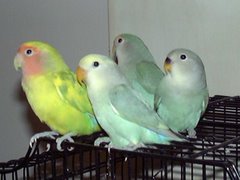Why Your Lovebird Is Shredding Paper and Tucking?
Most of the newbie lovebird owners don't know the reason why their lovebirds shreds paper and tucking. In general lovebirds think that they are born with an objective to shred and take every opportunity to do so. Some times, you can notice that the females will often tuck strips of shredded paper in their rump feathers. In some flock, males will also tuck the shredded paper but they're not so good in carrying the shredded paper. Both these lovebirds are carrying the shredded paper mainly with an intention to strengthen their nest by carrying more nesting material back to the nest.









 Free Ads For Bloggers
Free Ads For Bloggers

